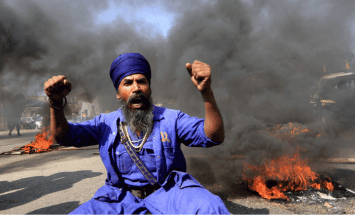

 As with all social movements, they begin often with a single issue. However, there can be no doubt that there are some important principles galvanizing the majority of the protesters in Punjab. These are the rule of law and due process, freedom from corruption, the separation religion from politics in management of Sikh institutions, release of political prisoners, prosecution of criminal police officers, rejection of religious fundamentalism and sectarian politics as advocated by the BJP/RSS.
As with all social movements, they begin often with a single issue. However, there can be no doubt that there are some important principles galvanizing the majority of the protesters in Punjab. These are the rule of law and due process, freedom from corruption, the separation religion from politics in management of Sikh institutions, release of political prisoners, prosecution of criminal police officers, rejection of religious fundamentalism and sectarian politics as advocated by the BJP/RSS. 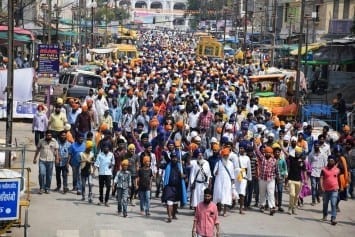

 The current crisis has generated its own exotic images: protestors whose poses and attitudes suitably reflect a “martial race” agitated over the desecration of the pages of a holy book; panj pyaras (whoever they are as far as people in the rest of the country are concerned) in colourful costumes taking the battle to the takht jathedars (whoever they may be). These images are accompanied by reports of “radicals” abroad, helped by the Inter-Services Intelligence (ISI), who somehow, according to the Punjab and central government, manage to manufacture trouble and assemble people in numbers that far exceed their miniscule strength in India and abroad.
The current crisis has generated its own exotic images: protestors whose poses and attitudes suitably reflect a “martial race” agitated over the desecration of the pages of a holy book; panj pyaras (whoever they are as far as people in the rest of the country are concerned) in colourful costumes taking the battle to the takht jathedars (whoever they may be). These images are accompanied by reports of “radicals” abroad, helped by the Inter-Services Intelligence (ISI), who somehow, according to the Punjab and central government, manage to manufacture trouble and assemble people in numbers that far exceed their miniscule strength in India and abroad.
The truth is that the origins of the current problems lie in the times in between, when the republic is looking away from Punjab. In a state dominated by the jutt Sikhs who are linked to each other by tribal kin and clan associations, democracy has always been a veneer. The forms of democracy, the legislature and the electoral process appear healthy but they lack substance. Work by the government does not take place through constitutionally mandated channels where citizens can demand services and accountability; instead it is carried out through a network of clan associations where loyalty to a leader is rewarded through patronage.
While this is true of all parties that come to power in Punjab, whether the Akalis or the Congress, the process has been further honed under the leadership of Punjab Chief Minister Parkash Badal of the Shiromani Akali Dal (SAD) and his son Sukhbir Badal. Individual leaders of the party, cabinet ministers and ostensibly powerful leaders in bodies such as the Shiromani Gurdwara Prabhandak Committee (SGPC), which controls all gurdwaras, are all directly beholden to the Badals and have little autonomy. The state has become a conglomerate run by the Badal family through patronage networks.
Three years ago when Parkash Badal and Sukhbir Badal leveraged the construction of a Bluestar Memorial to appropriate the figure of Jarnail Singh Bhindranwale, who, while he was alive, came close to putting the Akalis and Badal himself out of business. At that time, I had noted in an article titled A Community Led by Dunces, “…the voices that represent Sikhs do not speak for them. They represent the most regressive impulses of the community, and in ordinary settings, they would not be able to speak for a roomful of Sikhs, leave alone the entire community.”
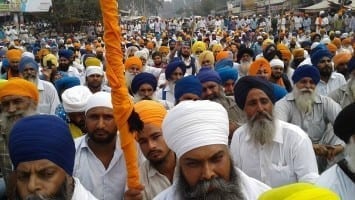

 What we are witnessing in Punjab today is a realisation of this simple fact. The protests that are unfolding in the state are the consequences of a community heartily sick of the people who claim to speak on its behalf. The Akali leadership is running scared from the very support base of orthodox Sikhs that it took for granted. These leaders are not safe in the gurdwaras they control through the SGPC, neither are they immune from social boycott and physical violence in rural Punjab, a territory they thought of as their own.
What we are witnessing in Punjab today is a realisation of this simple fact. The protests that are unfolding in the state are the consequences of a community heartily sick of the people who claim to speak on its behalf. The Akali leadership is running scared from the very support base of orthodox Sikhs that it took for granted. These leaders are not safe in the gurdwaras they control through the SGPC, neither are they immune from social boycott and physical violence in rural Punjab, a territory they thought of as their own.
The anger against the leadership has resulted is an anarchic popular agitation that is leaderless. It has no direction other than an assault on the existing power structure, which most people in Punjab see as centred around the Badals. It is this anarchy that has resulted in the agitation occasionally taking forms that are reprehensible, whether it be a clash between Sikh protestors and Hindu shopkeepers in Jalandhar or the unfurling of the banners of Khalistan at an agitation site.
To see a design in this, whether by the clichéd “foreign hand” or the ISI, is to miss the point. Even if there is evidence of this, and almost no one in Punjab is willing to believe the police amidst the current circumstances, what is unfolding on the ground would be much the same with or without this “outside help.” To seek such causes for the current development is to make the mistake of a labelling a popular movement that seeks radical change of the power structure within the state as seditious.
Those arrayed against the Badals range from farmers’ groups, which represent political views very much to the left of any political party in the state, to radical Sikh organisations that veer very much to the religious right of the Akalis. They have come together not because they have common goals but because they share a common resentment that has been building up over the past few months.
In May this year, there was popular outrage as well as demonstrations on the street after a 13-year-old girl was killed by being thrown off a Badal owned Orbit Aviation Company Bus, when she protested a molestation bid by the bus company’s employees. The matter was finally settled after Orbit gave the girl’s family a compensation of Rs 24 lakh.
Earlier this month a farmers’ agitation disrupted railway traffic through the state. The farmers were, in the main, demanding compensation for the failure of the cotton crop because of a pest attack. Badal pleaded an inability to meet these demands not because he did not feel they were justified but because the state did not have the resources to compensate the farmers. This did not go down well. In circumstances where the Badals’ own businesses are seen as thriving in Punjab, the state’s own failure to do well only adds to the simmering resentment. While media outlets in Delhi were focusing on the problem caused to rail commuters, the agitation was already poised to move on to the next stage where Akali leaders would be individually gheraoed by the farmers’ organisations. It was at this point that a number of incidents of the desecration of the Guru Granth Sahib began to be reported from across the state.
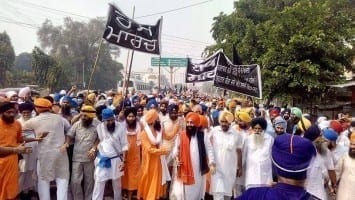

 The ground for religious resentment had already been built up again thanks to what was perceived as the Badals’ highhandedness. In September, the Sikh clergy had pardoned the head of the Dera Sacha Sauda, Gurmeet Ram Rahim Singh, over a 2007 charge of blasphemy. There was considerable anger in the community, less over the pardon and more over the manner in which it was granted. In an unprecedented move the Dera chief was granted a pardon without personally appearing and apologising before the Akal Takht. The anger was once again directed against the Badals’ because the Sikh clergy is seen as doing their bidding. The move was widely perceived as a trade off for the Dera chief’s support in the assembly elections that are due in early 2017.
The ground for religious resentment had already been built up again thanks to what was perceived as the Badals’ highhandedness. In September, the Sikh clergy had pardoned the head of the Dera Sacha Sauda, Gurmeet Ram Rahim Singh, over a 2007 charge of blasphemy. There was considerable anger in the community, less over the pardon and more over the manner in which it was granted. In an unprecedented move the Dera chief was granted a pardon without personally appearing and apologising before the Akal Takht. The anger was once again directed against the Badals’ because the Sikh clergy is seen as doing their bidding. The move was widely perceived as a trade off for the Dera chief’s support in the assembly elections that are due in early 2017.
This combination of both religious and secular anger that has built up over years is being released by the current agitation. It is quite possible that the Badals may be able to contain the physical manifestations of this disenchantment. However, the sentiments that drive it are not going to disappear. The Akali Dal has been central to the political and religious landscape of the state and it seems clear that the Badals’ control over their party and the state is soon going to be a thing of the past. It is not clear what will be born out of this anger. Neither the Congress nor the Aam Aadmi Party are well placed to provide an acceptable alternative and the Akali Dal lacks any leadership to replace the Badals. The future, then, holds out both hope, through an end to a discredited leadership, and foreboding, given the lack of any viable leadership that can see Punjab through this crisis.

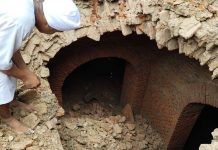
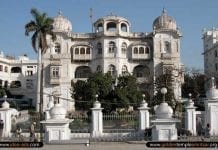


All leaders and Kingdoms have a life span including the Punjab’s ruler Maharaja Ranjit Singh .
We need a break from not so illustrious past which is full of traumatic events like the 1947 , 1984 etc etc.
We need a modern and Egalitarian party of 2015 .It should be able to lead us to a brighter and better future.
We have shining democracies in the world to Emulate from UK to USA to Canada on how to run a modern state.
We don’t want Politics on these petty issues like Sacha Sauda
It should be in sync with modern day Realities and World we live in.
We could call the new party if created by the masses as
1) Neo -Akali Dal or Punjab
2) Akali Dal or Punjab -2015
3) Protestant – Akali Dal or Punjab